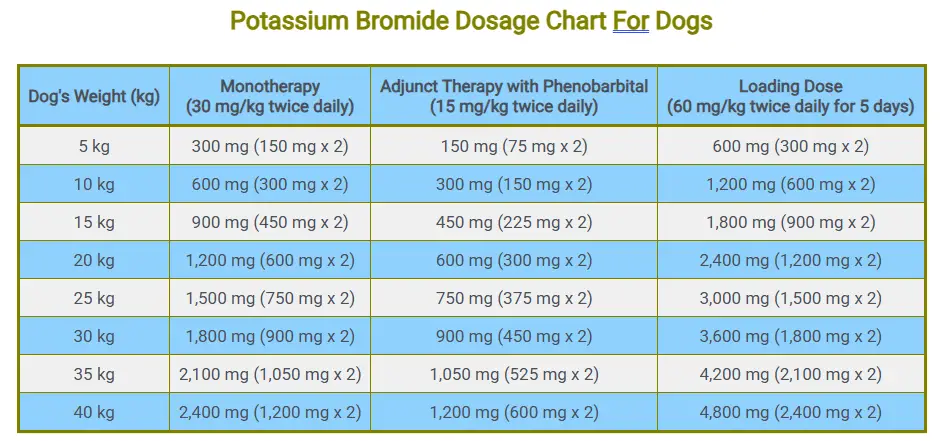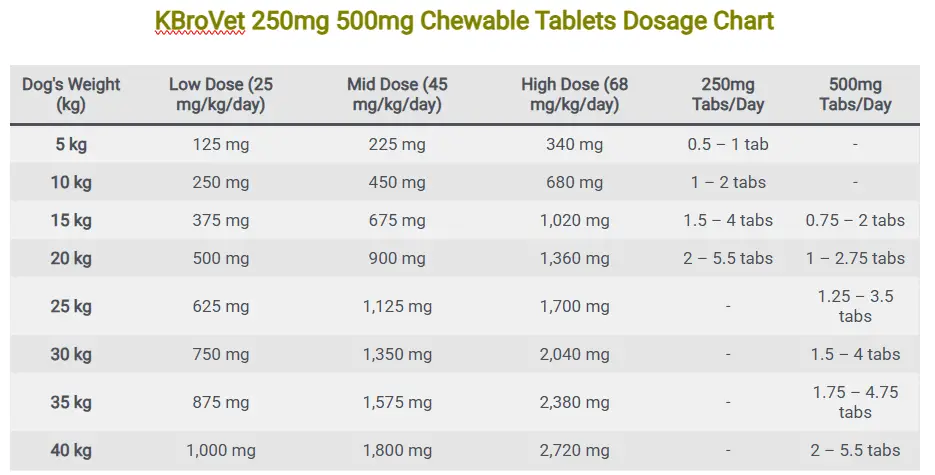When your dog is diagnosed with epilepsy or recurring seizures, one of the most common medications a vet might recommend is potassium bromide for dogs. It’s not exactly a household name, but it plays a crucial role in managing canine seizures, especially in dogs that can’t tolerate other anti-seizure medications like phenobarbital.
Knowing the right potassium bromide dosage for dogs is key—not just to control seizures effectively, but to avoid unwanted side effects.
This article will break down everything you need to know about potassium bromide for dogs, including a detailed dosage chart by weight.
If you’re a dog parent navigating the challenges of canine epilepsy, this guide will be your go-to resource. We’ll talk about what potassium bromide is, how it works, what factors affect its dosage, and of course, we’ll provide a clear dosage chart to help you understand how much your dog may need.
But remember—this is informational. Always talk to your vet before starting or adjusting any medication for your furry friend.
Potassium Bromide Dosage For Dogs
As monotherapy, the starting dose of potassium bromide is 30 mg/kg twice daily (totaling 60 mg/kg per day). When used with phenobarbital, the dose is reduced to 15 mg/kg twice daily (30 mg/kg per day). For dogs needing rapid seizure control or transitioning from phenobarbital, a loading dose of 60 mg/kg twice daily for 5 days (totaling 120 mg/kg per day) can be given to quickly reach therapeutic levels. Always consult your vet for proper dosing, especially in dogs under 10 kg.
Potassium Bromide Dosage Chart For Dogs
| Dog’s Weight (kg) | Monotherapy (30 mg/kg twice daily) | Adjunct Therapy with Phenobarbital (15 mg/kg twice daily) | Loading Dose (60 mg/kg twice daily for 5 days) |
|---|---|---|---|
| 5 kg | 300 mg (150 mg x 2) | 150 mg (75 mg x 2) | 600 mg (300 mg x 2) |
| 10 kg | 600 mg (300 mg x 2) | 300 mg (150 mg x 2) | 1,200 mg (600 mg x 2) |
| 15 kg | 900 mg (450 mg x 2) | 450 mg (225 mg x 2) | 1,800 mg (900 mg x 2) |
| 20 kg | 1,200 mg (600 mg x 2) | 600 mg (300 mg x 2) | 2,400 mg (1,200 mg x 2) |
| 25 kg | 1,500 mg (750 mg x 2) | 750 mg (375 mg x 2) | 3,000 mg (1,500 mg x 2) |
| 30 kg | 1,800 mg (900 mg x 2) | 900 mg (450 mg x 2) | 3,600 mg (1,800 mg x 2) |
| 35 kg | 2,100 mg (1,050 mg x 2) | 1,050 mg (525 mg x 2) | 4,200 mg (2,100 mg x 2) |
| 40 kg | 2,400 mg (1,200 mg x 2) | 1,200 mg (600 mg x 2) | 4,800 mg (2,400 mg x 2) |
KBroVet® 250mg 500mg Chewable Tablets Dosage Chart
| Dog’s Weight (kg) | Low Dose (25 mg/kg/day) | Mid Dose (45 mg/kg/day) | High Dose (68 mg/kg/day) | 250mg Tabs/Day | 500mg Tabs/Day |
|---|---|---|---|---|---|
| 5 kg | 125 mg | 225 mg | 340 mg | 0.5 – 1 tab | – |
| 10 kg | 250 mg | 450 mg | 680 mg | 1 – 2 tabs | – |
| 15 kg | 375 mg | 675 mg | 1,020 mg | 1.5 – 4 tabs | 0.75 – 2 tabs |
| 20 kg | 500 mg | 900 mg | 1,360 mg | 2 – 5.5 tabs | 1 – 2.75 tabs |
| 25 kg | 625 mg | 1,125 mg | 1,700 mg | – | 1.25 – 3.5 tabs |
| 30 kg | 750 mg | 1,350 mg | 2,040 mg | – | 1.5 – 4 tabs |
| 35 kg | 875 mg | 1,575 mg | 2,380 mg | – | 1.75 – 4.75 tabs |
| 40 kg | 1,000 mg | 1,800 mg | 2,720 mg | – | 2 – 5.5 tabs |
What Is Potassium Bromide?
Potassium bromide, often abbreviated as KBr, is an anti-epileptic drug used in veterinary medicine, particularly for dogs. It’s a salt that contains bromide ions, which help stabilize electrical activity in the brain. Unlike newer pharmaceutical drugs, potassium bromide has been around for a long time—over a century—and it’s still a go-to option for many veterinarians today.
What makes KBr particularly useful is its relatively mild profile. It’s less likely to cause liver damage compared to some other seizure meds, which makes it a solid choice for long-term use. It’s not FDA-approved for veterinary use (it’s considered off-label), but it’s still widely prescribed due to its proven efficacy and lower risk of liver toxicity.
KBr is usually given orally, in the form of tablets, capsules, or a liquid solution. The liquid is great for dogs who hate pills (and let’s be honest—most do). The drug is absorbed through the gastrointestinal tract and slowly reaches therapeutic levels in the blood. But here’s the kicker: it takes a while to build up. Unlike fast-acting drugs, potassium bromide needs a loading phase, which can take several weeks or even months before the full effects are felt.
Why Is Potassium Bromide Used for Dogs?
Potassium bromide is used to manage and prevent seizures, especially in cases where other drugs aren’t effective or aren’t tolerated. It’s not usually the first choice—phenobarbital often gets prescribed first—but it’s a fantastic second-line treatment or adjunct therapy. In many cases, it’s used in combination with phenobarbital for more effective seizure control.
One of its biggest advantages is that it’s relatively gentle on the liver, which makes it suitable for dogs with liver issues. Also, it’s excreted through the kidneys, which means it doesn’t put the same metabolic strain on the body as other medications. However, that doesn’t mean it’s risk-free—dogs on KBr need to be monitored closely, especially during the early phases of treatment.
How Potassium Bromide Works in a Dog’s Body
Mechanism of Action
Potassium bromide works by influencing the electrical signals in a dog’s brain. Essentially, it alters the flow of ions—specifically chloride ions across neuronal membranes. Bromide competes with chloride in the brain’s nerve cells, making it harder for the cells to reach the threshold needed to fire off an electrical signal (which would lead to a seizure). In simpler terms: potassium bromide calms down an overexcited brain.
This inhibition of nerve impulses helps prevent the brain from going into overdrive and causing a seizure. It’s not a cure, but rather a management tool to help your dog live a more stable, less seizure-prone life. The drug has a long half-life, meaning it stays in the bloodstream for a long time. That’s both a blessing and a curse—it helps maintain stable levels, but also means that any dosage changes take time to show results.
How Long It Takes to Work
This is where potassium bromide can test your patience. Unlike some medications that start working within days, KBr is slow to take effect. It can take anywhere from 2 to 4 months to reach therapeutic levels in the bloodstream unless your vet recommends a “loading dose” to speed things up.
During this initial phase, your dog may still experience seizures. Don’t panic—it’s normal. Regular blood tests are usually required to monitor bromide levels and adjust dosages as needed. Once the drug has stabilized in your dog’s system, you should start seeing fewer seizures—or ideally, none at all.
Factors Affecting Potassium Bromide Dosage
Age and Breed Considerations
Not all dogs are created equal when it comes to medication. Age plays a significant role in how potassium bromide is absorbed and processed. Puppies, for example, may metabolize drugs faster than older dogs, which means their dosage might need to be adjusted more frequently. On the flip side, senior dogs may have slower metabolic rates, so lower dosages are usually safer.
Breed is another major factor. Some breeds are more sensitive to bromide than others. For instance, toy breeds or dogs with small body mass may require more frequent monitoring due to the higher risk of side effects like ataxia. Breeds like Border Collies and Australian Shepherds, which are more prone to seizures, may also respond differently to the medication and may require higher starting doses.
Existing Health Conditions
Dogs with kidney issues need special attention when prescribed potassium bromide. Since the drug is excreted primarily through the kidneys, any impairment in kidney function can lead to drug accumulation and toxicity.
Liver function, although less critical in KBr metabolism, should still be considered, especially if your dog is on other medications that affect the liver.
It’s also important to monitor your dog’s diet. High-salt diets can alter bromide levels in the blood, making the medication less effective. That’s why consistency in your dog’s diet is crucial when they’re on KBr. Sudden changes in food or water intake can throw off the balance and reduce the drug’s effectiveness.
Concurrent Medications
If your dog is already taking other medications—especially anti-seizure drugs like phenobarbital—it can affect how potassium bromide works. These combinations can be beneficial but may also require careful dosage adjustments to avoid interactions.
Always let your vet know about any other medications, supplements, or herbal remedies your dog is taking. Even over-the-counter items can interact negatively with potassium bromide.
Signs of Potassium Bromide Toxicity in Dogs
Even though potassium bromide is generally considered safe for long-term use, it’s still possible to overdose—especially if you’re not careful with dosages, or if your dog’s kidney function is impaired. Overdose symptoms don’t usually appear suddenly. Instead, they creep in gradually, which makes it easy to overlook them at first.
Common signs of toxicity include:
- Wobbliness or Ataxia: This looks like your dog is drunk—uncoordinated and stumbling around.
- Lethargy: A normally active dog might become unusually sleepy or unwilling to move.
- Tremors: Shaking or trembling can be a sign that the nervous system is over-suppressed.
- Vomiting and Loss of Appetite: These can signal GI irritation, especially if the dose is too high.
- Extreme Sedation: Some sedation is normal, especially when first starting, but too much means the dose may be excessive.
- Increased Thirst and Urination: This can be a side effect or a sign that your dog’s kidneys are working overtime.
In extreme cases, severe bromide toxicity can lead to coma or death, but that’s rare and typically only occurs with very high or prolonged overdosing.
What To Do If You Suspect Toxicity
If you notice any of these symptoms, stop giving the medication and call your vet immediately. Your vet may recommend skipping a dose or reducing the dosage gradually. Don’t attempt to adjust it yourself—potassium bromide stays in the body for weeks, so changes need to be made slowly and carefully.
Treatment may include IV fluids to flush excess bromide out of the body more quickly. Your dog may also require hospitalization for monitoring, especially if symptoms are severe.
Side Effects of Potassium Bromide in Dogs
Potassium bromide is often well-tolerated, but like any medication, it can come with side effects—especially during the early stages of treatment. Most of these side effects are manageable and tend to subside as your dog’s body adjusts to the medication. However, knowing what to look out for can make a big difference in how you support your pup.
Here are the most commonly reported side effects:
- Lethargy and sedation: It’s normal for dogs to feel a bit “off” or drowsy when starting potassium bromide. This usually improves after a couple of weeks.
- Ataxia (loss of coordination): This is a big one. Your dog may seem clumsy or unsteady on their feet. It’s often dose-dependent and improves as the body adjusts.
- Increased appetite and thirst: These changes are sometimes confused with other conditions but can be tied directly to bromide’s impact on the nervous system.
- Behavioral changes: Some dogs may become more anxious or irritable, while others may seem spaced out or detached.
- GI symptoms: Nausea, vomiting, and constipation are possible, especially with sudden dose increases.
What can you do?
- Stick to consistent dosing times and amounts to avoid spikes or dips in blood levels.
- Give the medication with food to reduce gastrointestinal upset.
- Monitor behavior closely and maintain a journal of any new symptoms, especially within the first 6–8 weeks.
- Adjust dosage gradually and only under veterinary guidance.
- Stay patient. Many of the side effects will fade once your dog reaches a stable therapeutic level.
If symptoms are severe or getting worse, it’s critical to contact your vet immediately. Sometimes a dose adjustment or switching to another medication may be necessary.
Red Flags That Should Never Be Ignored
As much as we all want to manage things on our own, there are times when it’s absolutely critical to seek veterinary help—immediately. Potassium bromide is powerful, and while it’s usually well-tolerated, things can go south quickly if your dog’s body doesn’t handle it well.
Here are red-flag symptoms that need emergency attention:
- Persistent vomiting or refusal to eat
- Severe lethargy or non-responsiveness
- Extreme ataxia (unable to stand or walk)
- Seizures that become more frequent or last longer
- Unexplained collapse or fainting
- Sudden behavioral changes like aggression, disorientation, or confusion
These can indicate either toxicity, an underlying health condition, or that the medication simply isn’t working. Don’t wait it out—call your vet or an emergency vet hospital if your dog shows any of these signs.
Another situation to watch for is missed doses or accidental overdoses. If your dog gets into the medication and takes too much, or you miss multiple doses in a row, don’t guess—call your vet immediately. The half-life of potassium bromide means it can stay in your dog’s system for weeks, so even small deviations can have a lasting impact.
Being proactive rather than reactive could save your dog’s life. Keep emergency contact numbers handy, maintain detailed records of medications, and never hesitate to reach out to your vet with questions.
You May Also Like To Read:
Final Thoughts
Potassium bromide is a game-changer in the fight against canine epilepsy. While it isn’t a magic bullet, it offers thousands of dogs a chance at a seizure-free or seizure-controlled life—with far fewer side effects than some other medications. But, like anything involving your pup’s health, knowledge and consistency are key.
Understanding your dog’s specific dosage needs, using a reliable weight-based chart, and closely monitoring for side effects or toxicity will give you the upper hand in managing this condition. Don’t skip blood work. Don’t self-adjust dosages. And definitely don’t underestimate the importance of sticking to a routine.
Every dog reacts a little differently to potassium bromide, so work closely with your vet, observe your pup carefully, and stay the course. With the right approach, you’re giving your furry friend the best possible shot at a stable, happy life—even with epilepsy in the picture.
FAQs
Can potassium bromide cure my dog’s epilepsy?
No, potassium bromide doesn’t cure epilepsy, but it helps control seizures. Think of it like a dimmer switch—it lowers the intensity and frequency of the episodes so your dog can live more comfortably.
What if I miss a dose of potassium bromide?
Don’t double up. Just give the next scheduled dose and inform your vet if it happens frequently. Because the drug builds up over time, missing one dose won’t usually cause an immediate issue, but consistency is still crucial.
Is potassium bromide safe for long-term use?
Yes, when monitored properly with regular blood tests and vet checkups, potassium bromide is one of the safest long-term anti-seizure medications for dogs.
Can I give my dog potassium bromide with food?
Yes, and you should. Giving it with food helps reduce stomach upset and ensures better absorption. Try to feed your dog a consistent diet—changes in salt content can affect drug levels.
How soon will I see results after starting potassium bromide?
It varies. Most dogs start showing improvement within 4–6 weeks, but full therapeutic levels can take up to 4 months without a loading dose. Patience and monitoring are essential.












![Can Dogs Eat Blood? 7 Side Effects [Expert Opinion]](https://petskor.com/wp-content/uploads/2022/04/Webp.net-resizeimage-12.jpg)
